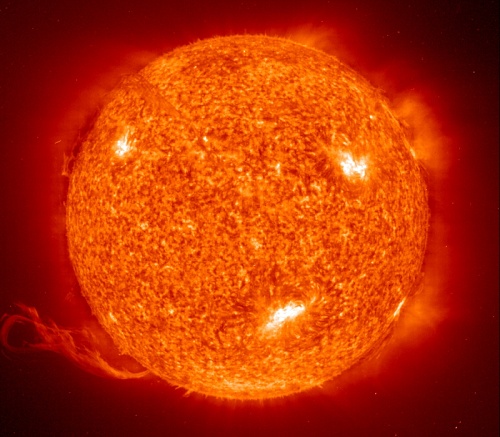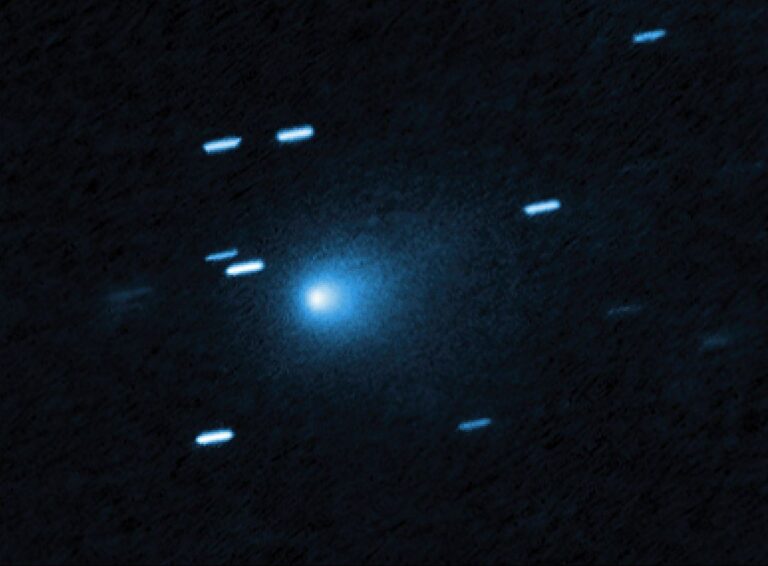Key Takeaways:
Like a sea anchor slacking the pace of a wind-driven ship, helium may be the drag that slows the solar wind in its million-mile-per-hour rush across the cosmos. And because the ordinary solar wind just can’t pull hard enough, the helium may build up in the solar atmosphere, until massive amounts of it are explosively expelled during eruptive solar events (called coronal mass ejections). These ejections produce the biggest near-Earth disturbances caused by solar wind. Those are the principal findings of researchers analyzing a decade’s worth of data collected by the Solar Wind Experiment, onboard the NASA spacecraft Wind.
Solar wind is a gas of electrically charged particles continuously emanating from the Sun that fills all of interplanetary space.
The Solar Wind Experiment measures the speed, density, and temperature of solar wind’s charged particles, primarily hydrogen with some helium and trace amounts of heavier elements. The measurement in space of hydrogen and helium has been a longstanding field of expertise for Los Alamos National Laboratory, whose John Steinberg shares responsibility for scientific interpretation with the institutions behind the experiment: NASA’s Goddard Space Flight Center, the University of New Hampshire, and the Massachusetts Institute of Technology.
“We study the solar wind for practical reasons; the character of the solar wind blowing by Earth at any time determines conditions in the near-Earth space environment,” Steinberg says. “We’ve flown instruments for similar solar wind measurements on spacecraft dating back to the 1960s. Currently, Los Alamos instruments are measuring the solar wind on the ACE and Ulysses spacecraft.
“It turned out that the Wind Solar Wind Experiment data were ideal for this particular study because of continuous data coverage that the spacecraft provided during the previous solar activity cycle minimum in 1996, through the recent solar max in 2001, and into the solar activity declining phase afterward,” says Steinberg. In addition, the Wind Solar Wind Experiment instrument turned out to be particularly well suited to giving accurate measurements at the slowest solar wind speeds.
On any given day, solar wind potentially affects Earth, satellites, and astronauts alike. Most effects are benign, but some solar wind effects strongly disturb space weather, which in turn can affect satellite operations. The team reported that the biggest disturbances are associated with eruptive events on the Sun called coronal mass ejections (different than solar flares), which incidentally have 5 to 10 times the amount of helium typically seen in solar wind.
“This result gives us another clue about how the solar wind is accelerated, which may help us better understand space weather,” says Justin Kasper of the Kavli Institute for Astrophysics and Space Research at the Massachusetts Institute of Technology and lead author of a paper published this month in Astrophysical Journal.
“We don’t yet understand a most basic aspect of the solar wind: how exactly does material in the solar corona accelerate to the solar wind speeds of between 600,000 and a million miles per hour?” Steinberg said. “The results of this study give us important clues. The clues came from having a look at the rare times when the solar wind is at its slowest, only 600,000 miles per hour, when it is almost all hydrogen and hardly any helium.”
In Earth’s atmosphere, helium is the really light stuff, allowing it to float above heavier oxygen and nitrogen. In the solar corona, however, most of the material is hydrogen, the lightest element, which should have an easier time than the heavier helium escaping the Sun’s gravity. “We suspect that as the hydrogen tries to escapes the solar corona, it always tends to drag some of the heavy helium with it. But dragging the helium along slows down the hydrogen.” It may be that 600,000 miles per hour is a rough speed limit, below which the helium applies too much drag on the hydrogen to let it escape, Steinberg explains.
The Solar Wind Experiment instrument on board the Wind spacecraft took some 2.5 million measurements over the course of more than 10 years.
“The instrument has been extremely stable over all this time, so we know the changes we see in the solar wind are real, and not just from changes in the instrument,” says Keith Ogilvie of Goddard Space Flight Center in Greenbelt, Maryland, principal investigator for the SWE instrument and a coauthor of the paper.
Launched in November 1994, Wind is the first of two NASA spacecraft in the Global Geospace Science initiative and part of the International Solar Terrestrial Physics Project.










